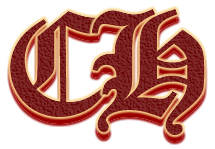History of the Cottesmore Hunt
In what follows, Michael Clayton traces the history of the Cottesmore Hunt from the time of Charles II to the present day. Michael's “History of Peterborough Royal Foxhound Show” is published by Quiller Press at £25. (Quiller Press, Wykey House, Wykey, Shrewsbury SY4 1JA, tel: 01939 2616; e-mail info@quillerbooks.com. Previous hunting books by Michael Clayton include: “A Hunting We Will Go”, “The Chase”, “The Golden Thread”, “Foxhunting in Paradise” (which includes a history of the Cottesmore), “Endangered Species” and “The Glorious Chase - a Celebration of Foxhunting”. He is former editor and hunting correspondent of Horse & Hound magazine.
Deer hunting and early forms of foxhunting took place for centuries in the East Midlands until the great forests of England were largely cleared in the 18th and early 19th centuries.
The Cottesmore Hunt's origins may be traced back to 1666 when Henry, Viscount Lowther made the long journey by a road with his own pack of hounds from Lowther Castle in Westmorland to Fineshade Abbey in East Northamptonshire.
The Lowthers had family connections in the Midlands, and they wished to hunt the widespread forests of Rockingham centred on the Castle overlooking the Welland valley on the southern borders of Leicestershire and Northamptonshire.
The Lowther family were to prove instrumental in the Cottesmore Hunt's later development, but they sold their pack in 1695 to Mr Thomas Noel on behalf of the Earl of Gainsborough.
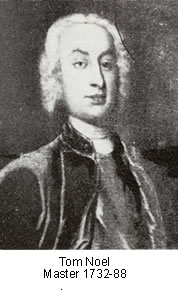 Noel was the agent managing the Gainsborough estates in the area of Cottesmore and Exton. The 5th Earl died in 1751 when his eldest son was aged only eleven, and in 1756 the widowed Countess married Tom Noel. He was an able manager, and passionate foxhunter, and he retained the hounds for the family, employing Arthur Abbey as huntsman; a “big heavy man with a rasping, strong voice,” whose relatives William and John Abbey acted as whippers-in. They were paid £35.12s.6d. per year from 1771-84.
Noel was the agent managing the Gainsborough estates in the area of Cottesmore and Exton. The 5th Earl died in 1751 when his eldest son was aged only eleven, and in 1756 the widowed Countess married Tom Noel. He was an able manager, and passionate foxhunter, and he retained the hounds for the family, employing Arthur Abbey as huntsman; a “big heavy man with a rasping, strong voice,” whose relatives William and John Abbey acted as whippers-in. They were paid £35.12s.6d. per year from 1771-84.
From 1696 to 1779 there had been a joint arrangement between the 3rd Duke of Rutland, Master of the Belvoir, and the Earl of Gainsborough, Earl Cardigan, Lord Howe and Lord Gower, to hunt one pack on a shared basis in the huge area from Belvoir southwards into East Northamptonshire. Hounds were moved between three different kennels, including Cottesmore, each season.
The Gainsborough family withdrew from this joint Hunt in 1732 and took 25 couple of hounds that began to hunt the country later known as the Cottesmore.
Tom Noel kept an excellent hunting diary that reveals a great deal of hunting in the Cottesmore area, then much more wooded. At that time Noel was sometimes frustrated by rural workers' families engaging in fox trapping, and the pack endured some blank days as well as many others when there was good sport. Their annual tally was seldom much more than 40 brace of foxes.
In 1776 Tom Noel made an agreement with Hugo Meynell, first Master of the Quorn, who virtually invented the modern practice of hunting the fox at speed in the open, and is known as the “Father of Foxhunting”. They agreed on boundaries between the Quorn and the Gainsborough pack, kennelled at Cottesmore, that enabled both packs to draw numerous coverts, including those at Owston, Launde and Tilton, nowadays well inside the Cottesmore country.
The 6th Earl never married and after Tom Noel's death, probably in 1788, the problem of succession in the Mastership was solved by the remarkable return of the Lowther family. Sir William Lowther bought the pack from the Gainsboroughs and hunted the Cottesmore country from 1788 until 1802 when he became Viscount Lowther, later elevated to Earl of Lonsdale in 1807.
He adored foxhunting, and spent seven months of the year hunting in Rutland and Leicestershire. At the end of each season he rode the 200 miles back to Lowther with the pack because he could not bear to be parted from them. The journey took four weeks each way. At first he rented Stocken Hall, but later rented Cottesmore House where he kennelled the hounds, and from which the pack derived its permanent name.
Sir William made the Cottesmore Hunt more widely popular, taking great trouble to breed his hounds to produce an effective working pack. “Earl William ” and his staff wore hairy flat-topped hats, and it is believed Surtees depicted them as “The Flat Hat Hunt”, with Lord Scamperdale as Master, in Mr Sponge's Sporting Tour.
The Cottesmore pack was purchased from the new Viscount Lowther in 1802 by Sir Gilbert Heathcote of Normanton Park, ancestor of the Earls of Ancaster. He was a great sportsman, owning many racehorses, including Derby winner Amarto. He employed an excellent huntsman, Philip Payne, with the celebrated horse-breaker Dick Christian as whipper-in.
However, after only four years, William Lowther, the new Earl Lonsdale made a triumphant return to the country he loved, resuming his Mastership, and continuing in office for another 36 years. He was a purist foxhunter who loved hunting the Cottesmore's remarkably wild country with large coverts and testing going. It was said that “Tilton, Loddington, Tugby , Skeffington and Launde were places where none should venture unless he had a stout horse”
The first Lord Lonsdale died only two years after reluctantly retiring, selling his horses and hounds in 1842. Sir Henry Sutton, Mr Henley Greaves, and Sir John Trollope provided a series of shorter Masterships up to 1870 when the Lowthers returned again.
During this time a large chunk of the country up to Whissendine was loaned to the excellent Master of his own pack, Mr Tailby of Skeffington who hunted much of the country that later became the Fernie.
By now Cottesmore subscriptions were being taken, and when Col. Henry Lowther, second son of the second Earl Lonsdale, became Master in 1870 they amounted to £400 a year, a large sum translated into to-day's currency. Henry Lowther bought hounds from Tailby for £1,300, another huge sum.
Henry lived at Asfordby before moving to Barleythorpe, north of Oakham, which his father purchased for him as a hunting box . Henry, later created 3rd Earl Lonsdale, built lavish kennels and stables at Barleythorpe from 1872.
Alas, he died aged 58, when he weighed 22 stone, and was succeeded by his eldest son, St George.
After two years under Lord Carrington, the Mastership was taken for a vital two decades, from 1880-1900, by Mr William Baird, with the excellent William Neal, and later George Gillson, as huntsmen. It was the hey-day of Victorian foxhunting, with increasing numbers of visitors flocking from all over Britain and overseas to hunt in the Shires that were a “sea of grass ” at that time.
Foxhunting in Leicestershire and Rutland became exceedingly fashionable, and relatively expensive compared with “provincial” Hunts elsewhere.
Second horsemen followed the field for the first half of the day when virtually everyone changed horses. Sport became faster, and the stiffly enclosed fly fence and timber country posed a challenge that leading horsemen were eager to take on. Many visitors took rented hunting boxes in Leicestershire and Rutland. The Cottesmore benefited from a growing number of wealthy newcomers who enjoyed living near Oakham and Uppingham and purchased properties for permanent residence. The Cottesmore was known to be “more residential” than its neighbour, the Quorn.
“Willie” Baird lived at Deanscroft, Oakham and gave the Hunt great leadership. He was a fine horseman, quietly authoritative, and exceedingly popular with those who relished “proper” foxhunting. The Hunt grew and prospered. From 1891 ladies as well as gentlemen were expected to pay subscriptions, and in 1893 caps were introduced for non-subscriber visitors, at £2 per day.
St George Lonsdale died at 26, and was succeeded by his younger brother Hugh Lonsdale, who was to become one of the most famous big-spending personalities of late Victorian and Edwardian Society, relishing in his nickname “The Yellow Earl ” which derived from the colour of his servants' livery and his carriages.
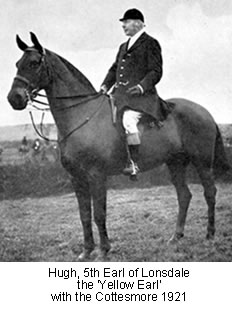 The 5th Earl was keen to take the Cottesmore Mastership and let the Barleythorpe kennels to the Hunt on an understanding that he would be Master in two years time. However, the Hunt's success made the committee more independent, and they chose to build new kennels and stables by Ashwell cross-roads. The handsome new kennels were intended to accommodate 100 couple of hounds, 50 horses, and housed most of the Hunt staff of some 40 grooms and kennelmen. The range of buildings on a spacious site was completed by the builder, Mr Hollis of Cottesmore, in 1889 for £6,777.
The 5th Earl was keen to take the Cottesmore Mastership and let the Barleythorpe kennels to the Hunt on an understanding that he would be Master in two years time. However, the Hunt's success made the committee more independent, and they chose to build new kennels and stables by Ashwell cross-roads. The handsome new kennels were intended to accommodate 100 couple of hounds, 50 horses, and housed most of the Hunt staff of some 40 grooms and kennelmen. The range of buildings on a spacious site was completed by the builder, Mr Hollis of Cottesmore, in 1889 for £6,777.
When Hugh Lonsdale sought the Mastership on Baird's retirement, there was some opposition to him, largely due to his explosive, autocratic Mastership of the Quorn from 1893 to '98.
Hugh Lonsdale stood aside with grace, and the highly successful new Master was Evan Hanbury for the first seven years of the 20th century. He employed the entertaining, if sometimes controversial, huntsman Arthur Thatcher, whose skills attracted even more visitors to the Cottesmore mounted fields.
The Yellow Earl was hunting with the Cottesmore, and was highly critical of Thatcher's slick style that could involve changing foxes rapidly. The Earl, a highly knowledgeable amateur huntsman, wrote to Thatcher a fascinating private letter of condemnation that became public, against the Earl's wishes, many years later. It remains a classic dissertation on hunting hounds.
Mr Hanbury, who lived at the Manor House, Braunston, was the great-grandfather of Mr Joss Hanbury, of Burley-on-the-Hill, who was to prove one of the most popular of modern Masters of the Cottesmore and the Quorn.
After Evan Hanbury resigned in 1907, Thatcher moved to the Fernie with much success, and the Cottesmore Mastership was finally in the hands of the Yellow Earl, but only until 1911. His autocratic style as Field Master was much resented by many in the Cottesmore country, and his Mastership ended amid some acrimony.
General Brocklehurst, later Lord Ranksborough, and an American, Mr Strawbridge, stepped into the breach for short Masterships, but the first World War put the Hunt into great difficulty, although limited hunting continued.
Hugh Lonsdale showed his true worth by generously taking the Mastership, not bearing any grudges, from 1915. He kept the Hunt afloat financially and provided excellent leadership for the next six years, ensuring its survival and continuity after the 1918 Armistice.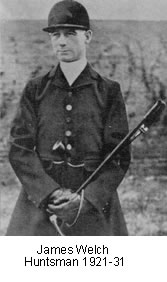
Still a great horseman and foxhunter, the Yellow Earl continued as Master until 1921 when he retired aged 63, and never hunted again. He spent his final years during the second World War at Stud House near Barleythorpe and died there in 1944, aged 87, much loved and appreciated in the Cottesmore country.
James Baird, son of “Willie”, became an excellent Master for the decade after 1921, joined by Col. Sydney Green.
From 1931, the Cottesmore's Master Major Chetwode Hilton-Green, forged a major reputation as one of the finest amateur huntsmen in the land. “Chatty ”, as he was always known, hunted hounds impeccably to catch his fox, and at the same time provided considerable sport for keen mounted fields. He was immensely admired by the young Ronnie Wallace in the 1930s.
The Cottesmore's pre-war hunting, in its superb grass country, before the advent of busy main roads and lanes and Rutland Water, was reported with warm praise in the sporting press.
Lady (Nairne) Tate, wife of Sir Henry Tate, later to be a popular Master, wrote of Hilton-Green: “The wonderful pack he bred, the sport he showed and his genius in the handling of hounds will remain forever in the memory of those who had the good fortune to enjoy those seasons between the wars when he made foxhunting history. ”
His mainstay for many years was Herbert Norman as whipper-in and kennel-huntsman, backed by his son John as second whipper-in. Chatty, who had served in the first war, returned to hectic military service in the second war, but remained Master of the Cottesmore until 1946. 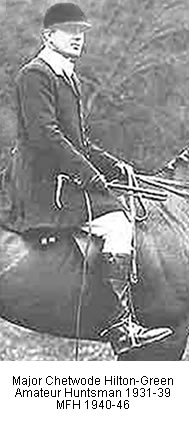 His wife, the former Lady Helena Fitzwilliam, known to foxhunters as “Boodley”, was a passionate foxhunter and played a great part in keeping the Cottesmore country going during the war, aided by Herbert Norman. Chatty left the Cottesmore, immensely missed by his followers, to hunt the Berkeley and other packs, before retiring in 1964, two years before his death.
His wife, the former Lady Helena Fitzwilliam, known to foxhunters as “Boodley”, was a passionate foxhunter and played a great part in keeping the Cottesmore country going during the war, aided by Herbert Norman. Chatty left the Cottesmore, immensely missed by his followers, to hunt the Berkeley and other packs, before retiring in 1964, two years before his death.
The Cottesmore's amateur huntsman tradition was maintained from 1946-58 by two Colonels, Lt. Col. Sir Henry Tate, and Lt. Col Cyril Heber Percy. They shared the hunting of hounds, Cyril hunting the Rutland and Leicestershire side, and Henry Tate mainly hunting the Lincolnshire country, east of the A1. The country was still largely grassland, and soon attracted large, keen-riding post-war mounted fields. The Masters were delightful personalities and deservedly popular. They were joined in the Mastership by Mr Malcolm McAlpine and Mr Marcus Kimball MP, now Lord Kimball the Hunt President.
Sir Henry's cousin, the late R.W. “Mickey”Gossage, was Hunt secretary from 1939 to 1970, and is remembered by a covert bearing his name.
Another notable amateur huntsman succeeded as Master in 1958: Major Robert Hoare, always genial, and a great believer in foxhunting providing as much fun as possible for the mounted fields. Bob Hoare, from the arable West Norfolk, adapted remarkably well to Rutland and Leicestershire, although he saw the onward march of a change of farming from grass to plough encroaching through much of the Cottesmore country. He moved to hunt the South Notts pack, and worked ceaselessly as fund raiser for the British Field Sports Society; he died suddenly in 1976.
His successor at the Cottesmore, Capt Simon Clarke, was one of the most prominent amateur huntsmen, having already achieved much in the South Dorset country.
He updated the Cottesmore's hound breeding, and produced excellent sport in an all-too-short Mastership of seven years.
Mr David Samworth, Mrs Di Hellyer and Mrs Joan Gibson, all devoted and highly experienced foxhunters who had long hunted with the Cottesmore, formed a highly effective Mastership next, with Peter Wright hunting hounds as a most capable professional until 1981.
Then Capt Brian Fanshawe arrived from the North Cotswold country to bestow on the Cottesmore a highly effective Mastership as amateur huntsman for the next 11 years. Consummate horseman, innovative hound breeder, and above all, a persistent fox-catcher, Brian Fanshawe earned a splendid reputation in providing consistent sport, and in running the country.
He and his wife Libby lived in the country, latterly at Ladywood in the heart of the Tuesday country still clothed with grass, and Brian gave firm leadership to the Hunt on and off the hunting field.
Mr Joss Hanbury, Mr Leslie Dungworth, his son Roger, Mrs David Samworth, and Mr Tony Ruddle, all served as excellent Joint Masters with Brian Fanshawe for varying terms, producing effective teamwork at a time when hunting's environment, and the political climate, were changing rapidly. Neil Coleman arrived from Gloucestershire with Brian Fanshawe, and rose from second to first whipper-in. In 1992 he was established as professional huntsman, succeeding “the Captain ” from whom he had learned so much in handling and caring for hounds. In 2006 Neil's 25th anniversary with the Cottesmore was warmly celebrated by the Hunt at a special end-of-season meet and a party at Brooke Priory. He was especially praised for rising to the challenge of hunting hounds effectively in the first season following Labour's iniquitous attempt to ban hunting with hounds through its Hunting Act 2004, enacted the following February, shortly before the end of that season. Neil's hound control and long experience of the Cottesmore country proved great assets at a difficult time.
Neil Coleman arrived from Gloucestershire with Brian Fanshawe, and rose from second to first whipper-in. In 1992 he was established as professional huntsman, succeeding “the Captain ” from whom he had learned so much in handling and caring for hounds. In 2006 Neil's 25th anniversary with the Cottesmore was warmly celebrated by the Hunt at a special end-of-season meet and a party at Brooke Priory. He was especially praised for rising to the challenge of hunting hounds effectively in the first season following Labour's iniquitous attempt to ban hunting with hounds through its Hunting Act 2004, enacted the following February, shortly before the end of that season. Neil's hound control and long experience of the Cottesmore country proved great assets at a difficult time.
Since Brian Fanshawe's Mastership, the Cottesmore was maintained at a high level by a series of Joint Masterships. Mr Kim Smith-Bingham served with Mr Tim Vestey and Miss Louise Bates. Mrs David Samworth served for a second term, and others in the Masterships up to 2005 were Mr David Manning, Mr Johnny Weatherby, Mr Nick Wright, Mr Charlie Gordon-Watson, Mr William Bevin, Mr Tim Hercock, and Miss Clare Warman. Mr Roger Dungworth remained in office for a remarkable 13 years in which he looked after the Lincolnshire country most effectively, retiring in 2005. The Cottesmore has been fortunate in long-serving Hunt Secretaries: Micky Gossage was succeeded by Joanna Spencer (20 years to 1981), Michael Stokes (24 years to 2003) and since 2003, Clare Bell.
A new Mastership took responsibility after the 2004-5 season: Mrs Jane Knight with Mr William Cross and Mr Charlie Gordon-Watson. They coped remarkably with the new pressures imposed by the Hunting Act in the 2005-6 season, and were staunchly supported by the farmers and landowners of the Cottesmore country. The current mastership can be seen here.
An additional challenge to the Hunt in recent years was the sale of the Hunt Kennels and land at Ashwell cross-roads for housing development. The buildings were becoming expensive to maintain, and the increasingly busy road outside was dangerous for horses and hounds. Under the chairmanships of Lord Kimball and Mr Nick Cheatle, the Hunt acquired new premises and 40 acres of land by the Cottesmore road at Ashwell, and built a completely new range new kennels and stables.
Neil Coleman and staff managed to provide consistent sport in the 2004-5 season while the pack was kennelled temporarily in the Belvoir Hunt kennels.
In 2005 the new Cottesmore kennels were occupied, and the first puppy show held there.
The Cottesmore has been greatly aided postwar by the Hunt Supporters' Club, of which Mrs Leslie Dungworth was chairman for many years, succeeded by Miss Mary Anne Donovan, and in 2005 by Mrs Christine Hawksfield. The high level of support from subscribers, supporters, and farmers and landowners enables the Hunt to face the future with confidence, in the hope that the Hunting Act will be repealed, or considerably amended.
